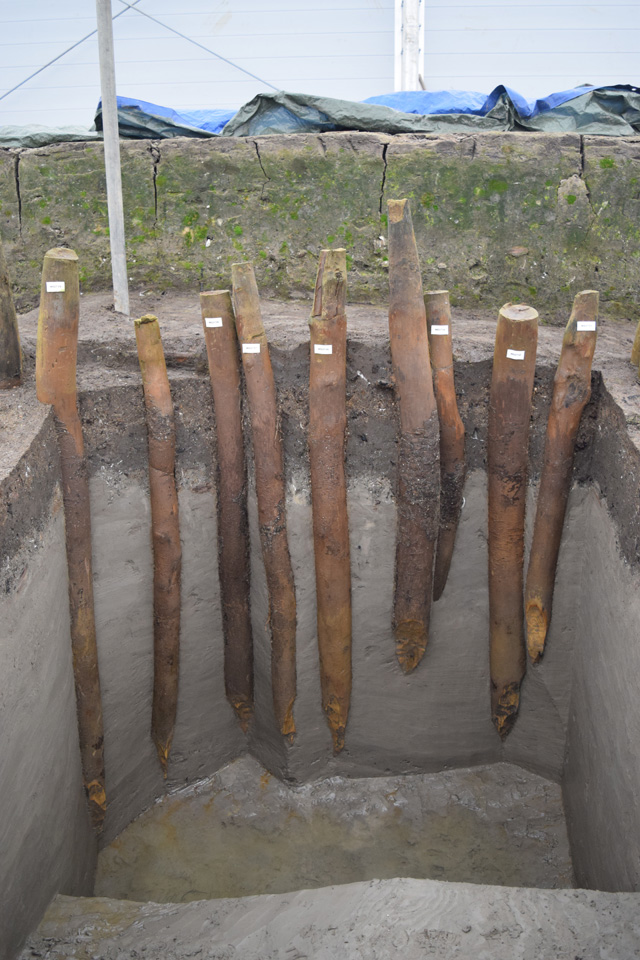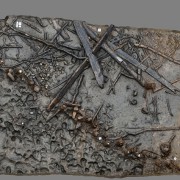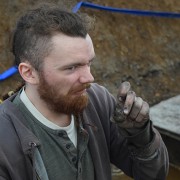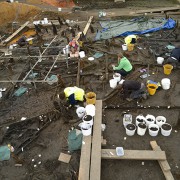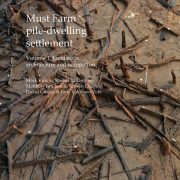Post-Ex Diary 1: Finishing the Excavation
September 24, 2016
Excavating and Recording the Remaining Archaeology
It seems like a long time ago that we began to remove the two metres of sediment that sat above the remains of the Must Farm settlement. After over 10 months of hard work, we have finished the excavation and the site has been reburied. It’s been a very busy few weeks as everyone in the team has worked extremely hard to complete all of our recording alongside preparing artefacts and materials for post-excavation analysis and storage.
In the last few weeks of the excavation, we were concentrating on unearthing a representative sample of uprights from the houses, palisade and the earlier timber causeway. This was no easy task, as we had to carefully excavate slots into the roddon silts next to the posts, before gently extracting them. At this point we could then photograph and record any tool markings present which is a relatively time-consuming, detailed process.
Once this task was completed, a final set of environmental samples from the lowest deposits of the site were taken. These samples reflect layers of silt that either date from the earliest stages of the settlement, or pre-date its construction. As such, they are very useful as comparative tools to see how environmental data changed as the settlement developed, was occupied and ultimately was destroyed. With over 1,000 samples taken from Must Farm, much of the post-excavation work will involve processing and examining their contents in detail using a variety of specialists.
However, one of the main areas we were focusing on was the cataloguing and packaging of wooden objects and timbers from across the site. Throughout the excavation we have had a group of archaeologists dedicated to recording and lifting timbers, dubbed the “wood team”. Over the 10 months of the project, we’ve recorded well over 5,000 pieces of wood. This staggering amount has included everything from minute woodchips to enormous oak timbers.

Image of a differentially charred timber. Timbers with unusual markings or signs of working were recorded and retained, ready to be conserved.
Owing to the sheer quantity of wood at the settlement, it was not possible to conserve and retain it all. Instead, most timbers were recorded with the more unusual, or exceptional, pieces of wood being selected to be packaged up for conservation work once the excavation was completed. This still resulted in hundreds of timbers and wooden artefacts being retained and preparing them for temporary storage involved lots of cataloguing and packaging.
When a piece of timber was selected for retention, it was recorded once it was lifted from its position on-site. Details such as precise dimensions, charring patterns, wood species, tool marks and many more were logged in specially produced wood recording sheets. At this stage the wood chosen for conservation would then be photographed to have record shots of the condition and any key features, such as signs of working or joints. Similarly, the objects were carefully illustrated to produce detailed scale drawings highlighting various elements which may not have been clearly visible on photographs.

Image showing carefully wrapped and packaged timbers ready to be sent to refrigerated, dark storage. This is temporary until the objects are sent on for long-term conservation.
After this recording was completed, the timbers were catalogued with an additional set of unique numbers while notes on their condition and completeness were compiled. The next stage was to make sure the wood was sufficiently waterlogged to prevent decay by heavily spraying them with water. Once this was done the timbers were packaged in thick plastic and carefully sealed to prevent any moisture escaping.
These carefully packaged pieces of wood were then transferred to a temporary storage unit with a special set of conditions to keep the timbers stable and prevent them from decaying. The storage container is refrigerated and completely dark, which helps to prevent the development of living organisms which would damage the wood. This is only a temporary measure while the wood is still being examined and studied in greater detail. After this has been completed the timbers will be sent on for long-term conservation, a process which will take some time.
Reburying the Site
With the remaining wood recorded and packaged, we had reached the end of the excavation. We had completed what the project set out to do: to record and remove the settlement archaeology from the site. We were effectively left with an empty hole in the ground with the archaeology, both artefacts and structural material, having been carefully recorded and then lifted. However, we have gathered an enormous body of evidence to analyse and explore over the coming years.

Image showing the site having been reburied with the warehouse being carefully packaged up. The excavation phase of the Must Farm project has now finished.
All that remained was to carefully rebury the site by backfilling it with a layer of clay and to disassemble the warehouse that had protected the excavation from the elements for almost a year. When this was completed, the remainder of the ground was restored leaving the site as it had been in July 2015.
The reburying of the site has brought about a definite end to this phase of the project, however from this point onwards a new chapter begins. The months of work in the field has laid the groundwork for a whole series of detailed scientific investigations to take place, exploring the Must Farm settlement in much finer detail. By recording and removing the archaeology, we have guaranteed that the subtle environmental information and more delicate finds haven’t disappeared over time.
Over the coming months, and years, we’ll be posting updates reporting our latest findings and discoveries as we begin the post-excavation process. Results will not be as immediate as during the excavation itself but they will offer details at a variety of scales: from microscopic environmental data to greater structural details about the houses. Despite the digging being done, the Must Farm project is very much continuing and we are all very excited to share more of our discoveries as we make them.
Related stories
Post Ex-Diary 22: Working Towards Publication
May 11, 2020
Post Ex-Diary 21: The Importance of Visualisation – Photography Part Two
February 17, 2020
Post-Ex Diary 19: The Importance of Visualisation – Illustration
December 9, 2019
Post-Ex Diary 18: The Importance of Visualisation – Photogrammetry
November 11, 2019
Post-Ex Diary 17: Stable Isotope Analyses and Must Farm
October 7, 2019
Post Ex-Diary 16: Parasites and Lifestyles at Must Farm
September 3, 2019
Post Ex-Diary 15: Exploring Structure 4 Part Two
August 5, 2019
Post Ex-Diary 14: Exploring Structure 4 Part One
July 15, 2019
Post-Ex Diary 13: The Must Farm Pile-Dwelling Settlement Open Access Antiquity Article
June 12, 2019
Post-Ex Diary 11: The Must Farm Textiles Part One
April 1, 2019
Post-Ex Diary 10: Specialist Analyses Part Three
March 4, 2019
Post-Ex Diary 9: Specialist Analyses Part Two
February 4, 2019
Post-Ex Diary 8: Specialist Analyses Part One
January 7, 2019
Post-Ex Diary 7: The Must Farm Pottery Refit
November 5, 2018
Learn more
About
The Must Farm pile-dwelling settlement was excavated by the Cambridge Archaeological Unit with funding from Historic England and Forterra.Publications
Read the Open Access publications the Must Farm pile-dwelling settlement: Volume 1. Landscape, architecture and occupation and Volume 2. Specialist reports.Dig Diaries
The excavation of the Must Farm settlement was carried out between August 2015 and August 2016. Take a look at our diary entries documenting the excavation process. ...read more
Discoveries
See some of the discoveries from the Must Farm pile-dwelling settlement.
Making Must Farm
Find out about our work with AncientCraft recreating Must Farm’s material.
FAQs
Further information on the Must Farm project.

